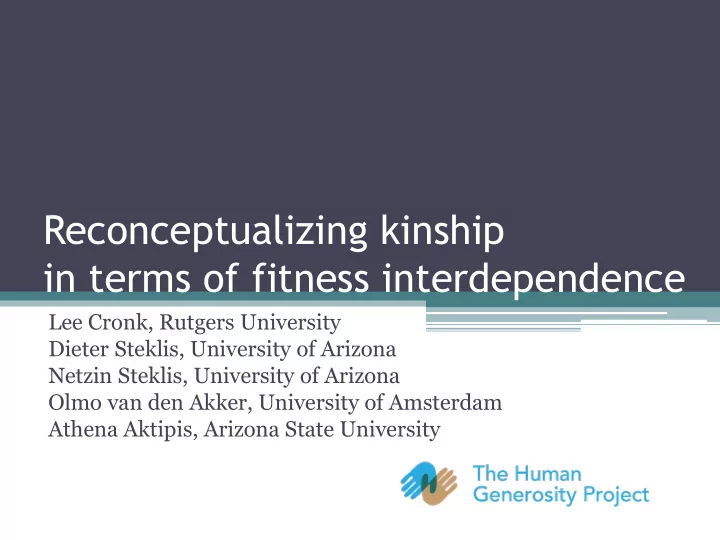

Reconceptualizing kinship in terms of fitness interdependence Lee Cronk, Rutgers University Dieter Steklis, University of Arizona Netzin Steklis, University of Arizona Olmo van den Akker, University of Amsterdam Athena Aktipis, Arizona State University
Question: Assuming paternity is not in question, what is your average genetic relatedness to your father’s sister’s son? Answer: 12.5% or 1/8, i.e., the same as any first cousin.
Question: What do you call your father’s sister’s son? (a) The same thing you call your father’s brother’s son and all your mother’s siblings’ sons, but not what you call your brother (b) The same thing you call your brother (c) The same thing you call your mother’s brother’s son but not the same thing you call your brother, your father’s brother’s son, or your mother’s sister’s son (d) The same thing you call your sister’s son and your daughter’s son (e) The same thing you call your father and your father’s brother (f) A term that you use for no relative other than your father’s sister’s son (g) Any of the above, depending on where you come from.
Question: What do you call your father’s sister’s son? (a) The same thing you call your father’s brother’s son and all your mother’s siblings’ sons, but not what you call your brother (Eskimo) (b) The same thing you call your brother (Hawaiian) (c) The same thing you call your mother’s brother’s son but not the same thing you call your brother, your father’s brother’s son, or your mother’s sister’s son (Iroquois) (d) The same thing you call your sister’s son and your daughter’s son (Omaha) (e) The same thing you call your father and your father’s brother (Crow) (f) A term that you use for no relative other than your father’s sister’s son (Sudanese) (g) Any of the above, depending on where you come from.
“... there is not a single system of marriage, postmarital residence, family organization, interpersonal kinship, or common descent in human societies that does not set up a different calculus of relationship and social action than is indicated by the principles of kin selection .” -Marshall Sahlins, 1976, p. 26
Sahlins ’ conclusion (and that of many other cultural anthropologists, as well): Kin terminologies have nothing whatsoever to do with anything biological, including but not limited to degrees of genetic relatedness.
An alternative conclusion Kin terminologies have more to do with fitness interdependence broadly, the specifics of which vary from society to society, than with genetic relatedness specifically.
This argument was anticipated by Austin L. Hughes (1949-2015) “. . . kinship terminologies group individuals in ways that are biologically important and concentrate attention on biologically significant individuals.” Hughes 1988:129
Fitness interdependence: what it is • The degree to which two or more organisms influence each other’s success in replicating their genes. - Aktipis et al. In press. Nature Human Behaviour
Fitness interdependence: How it arises • Genetic relatedness (shared ancestors) • Mating and marriage (shared descendants) • Dependence on same parents or other caregivers (e.g., alloparents) • Risk pooling arrangements • Membership in the same corporate descent group • Membership in same religious group • Warfare and other forms of intergroup conflict
Fitness interdependence: how to model it
Fitness interdependence: how to model it (a) Hamilton’s Rule: rb – c > 0 (b) Robert’s Stakeholder Model: sb – c > 0 Where s = the altruist’s stake in the welfare of the recipient
Fitness interdependence: how to measure it Perceived Fitness Interdependence Scale (PFIS): • When [X] succeeds, I feel good. • When [X] fails, I feel bad. • I feel that [X]'s gain is my gain. • What is good for [X] is good for me. • Honestly, I don't care whether [X] thrives or not. (RC) • [X] and I rise and fall together.
Reported willingness to Reported willingness to help help as a function of as a function of genetic Perceived Fitness relatedness Interdependence (Sznycer et al., in prep.)
The six basic kin term systems reflect different but cross-culturally recurrent patterns of fitness interdependence
Associated with a lack of corporate descent groups and importance of nuclear families
Associated with prescriptive cross-cousin marriage
Associated with matrilineality
Associated with patrilineality
Associated with ambilineality
Usually found in complex, hierarchical societies
When fitness interdependence patterns change, so do kin terms • Old English shifted from the Sudanese to the Eskimo system when extended kin ties weakened and nuclear families became more important (Schwimmer 2003) • Choctaw shifted from matrilineality and the Crow system to patrilineality and the Omaha system following their forced move to what is now Oklahoma (Eggan 1937)
People often extend kin terms to non-kin with whom they are highly interdependent • “Band of brothers” among soldiers in combat • Osotua (“umbilical cord”) as a quasi-kin term among Maasai
Future work on kin terms and fitness interdependence Helen Tom Conte Wasielewski Diego Cathryn Townsend Guevara Beltrán
Acknowledgments American Center for Mongolian Studies
Recommend
More recommend